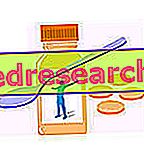Generality
Schizoaffective disorder is a pathological condition in which the symptoms of schizophrenia are associated with the typical manifestations of depression or bipolar disorder .

More in detail, the subject manifests a depressive, manic or mixed (bipolar) episode, in conjunction with two or more psychotic symptoms (consisting mainly of delusions, delusions of persecution and / or hallucinations), for at least 1 month. Once this period has passed, the person with schizoaffective disorder continues to have the symptoms of the schizophrenic component for at least 2 weeks, in the absence of significant changes in mood.
The precise causes of this disease are not yet known. The course of schizoaffective disorder is usually episodic, but it is not excluded that the patient may develop pure schizophrenia or a mood disorder (major depression or bipolarity).
Schizoaffective disorder can be tackled with a combination of drugs and psychotherapy, which allows the symptoms of the disease to be managed in the best way.
What's this
Schizoaffective disorder is a psychiatric illness in which a person, who already has some symptoms of schizophrenia, also begins to experience a mood disorder (depression or bipolar disorder). This clinical picture, to be defined from the diagnostic point of view, must be presented continuously, for at least a month. Once this period has passed, the person with schizoaffective disorder continues to have the symptoms of the schizophrenic component.
Forms of schizoaffective disorder
In schizoaffective disorder, schizophrenic or schizophrenosimilar manifestations are associated with a unipolar (major depressive disorder) or bipolar affective component.
Therefore, two subgroups can be distinguished:
- Schizoaffective disorder of the Bipolar (or manic) type : if the disorder includes a manic episode (corresponds to the normal temperament of the individual and manifests itself with typical behaviors: the mood is high and the subject is hyperactive, talkative, uninhibited and has excesses of self-esteem) or mixed (in practice, the patient experiences moments of extreme euphoria and excitement alternating with a severe depression);
- Depressive schizoaffective disorder : if the disorder includes only the symptoms of major depression.
Causes
The causes of schizoaffective disorder are not yet known. However, this condition is likely to depend on the combination of several factors. The latter seem to act significantly on a biological basis and a genetic component, which make the subject predisposed to the development of the disease.
As far as epidemiology is concerned, there are no precise data on the percentage of psychiatric pathology, but it is known that schizoaffective disorder is rarer than schizophrenia, with greater risk for women.
Typically, schizoaffective disorder occurs in adulthood, but may also appear during adolescence.
Familiarity with schizophrenia and / or a mood disorder is considered an important risk factor, in the sense that a person with first degree relatives affected by these conditions is more likely to develop schizoaffective disorder.
Symptoms and Complications
Schizoaffective disorder is characterized by an alternation of phases in which mood changes (depression or manic or mixed type episodes) and psychotic symptoms (consisting mainly of delusions and / or hallucinations) occur, followed by a phase of well-being.
Over time, schizoaffective disorder can lead to a loss of contact with reality (psychosis) and the processing of unusual thoughts, which can lead the subject to isolation or asociality (lack of interest in human relations).
Main events
In periods of exacerbation of schizoaffective disorder, the subject may exhibit various symptoms, including:
- Delusions (fixed ideas and erroneous beliefs, not corresponding to reality, despite evidence to the contrary; this manifestation is typical of schizophrenia);
- Hallucinations (false and distorted perceptions; the subject affected by schizoaffective disorder incorrectly perceives what is imaginary as real).
- Disorganized speech (inconsistent, illogical or incomprehensible);
- Catatonia (loss of motor initiative and insensitivity to external stimuli, positive or negative);
- Paranoia;
- Bizarre and inadequate motor behavior (psychomotor agitation, inadequate conduct or appearance, neglect of dress and personal hygiene);
- Flattened affectivity (no special emotions) or inadequate (eg emotional distance).
Regarding the schizoaffective disorder of the depressive type, the person can manifest:
- Loss of initiative and interest in any activity;
- Sadness, demoralization, recurrent negative thoughts and feelings (such as death and suicide);
- Irritability;
- Guilt feelings;
- Fatigue and lack of energy;
- Concentration problems;
- Loss of appetite;
- Social isolation.
As for the bipolar schizoaffective disorder, instead, they are possible:
- Irritability and labile mood;
- Mania (mood characterized by elevated mood, excitement, increased productivity and optimism) or hypomania;
- Self-esteem beyond the norm;
- Increase in talkativeness (tendency to speak quickly, in an incessant and sometimes theatrical way; the flow of ideas, initiatives and thoughts can be chaotic and meaningless);
- Easy distractibility and attention deficit;
- Reduced need for sleep;
- Impulsivity;
- Unruly, improper and irresponsible behavior.
Course
- The course of schizoaffective disorder is generally episodic.
- Schizoaffective disorder usually resolves within 6 months, but there are cases in which the manifestations may gradually worsen to the point of determining the clinical picture of pure schizophrenia . At other times, the pathological condition precedes major depression or bipolar disorder .
- The prognosis is slightly more favorable than in schizophrenia, but it is worse than that of mood disorders.
Diagnosis
The diagnosis of schizoaffective disorder is clinical and is considered by the psychiatrist specialist when a psychotic patient also presents disorders of the mood. The distinction of schizoaffective disorder from schizophrenia and mood disorder with psychotic manifestations is not simple.
To understand the extent of the disease and establish an adequate intervention plan, the doctor submits the patient to some interviews, to gather information regarding the level of impairment of the general functions and the characteristics with which the symptomatology is manifested (for how long and with what intensity). This assessment also aims to find the links between the discomfort experienced by the patient and the factors that trigger or contribute to maintaining schizoaffective disorder.
Diagnostic criteria
To formulate the diagnosis of schizoaffective disorder it is necessary that there are significant affective disorders (depressive, manic or mixed), simultaneously with two or more symptoms of schizophrenia (delusions, hallucinations, disorganized speech, disorganized or catatonic behavior) for the duration of at least 1 month, continuously. Furthermore, delusions or hallucinations must occur for at least 2 weeks, in the absence of relevant symptoms concerning mood.
The latter must be presented, then, for a considerable part of the total duration of the active or residual periods of the disease.
Differential diagnosis
The distinction of schizoaffective disorder from schizophrenia and mood disorders may require a cross-sectional evaluation of symptoms and their course.
- In schizoaffective disorder, there is an episode of mood alteration concomitant with the symptoms of the active phase of schizophrenia;
- On the contrary, in schizophrenia the symptoms concerning the mood manifest themselves for a short time compared to the total period in which the disorder is present, manifesting itself only during the prodromal or residual phases;
- In mood disorders with psychotic manifestations, however, the symptoms occur exclusively during periods of mood alteration.
During the evaluation, the psychiatrist must exclude that schizoaffective disorder is the direct physiological consequence of a general medical condition (such as, for example, metabolic disorders, systemic infections, syphilis, HIV infection, epilepsy or brain injury).
To ascertain other possible organic causes that can produce similar psychoses, the doctor can indicate to the patient a neurological examination and the performance of blood chemistry or instrumental tests.
Treatment
Once the diagnosis of schizoaffective disorder is confirmed, a supportive therapeutic intervention can be established. In this process, we generally tend to involve family members, as the patient may not recognize his or her state in full autonomy and may not be objective in recognizing the factors responsible for the development and maintenance of the disorder.
The treatment of schizoaffective disorder often makes the combination of two main strategies necessary:
- Psychotherapy : consists in providing the patient with clear and specific information on his disorder (eg symptoms, course, etc.), to help him manage the symptoms and reduce the social dysfunction that entails;
- Drug therapy : prescribed for the purpose of alleviating psychotic symptoms, stabilizing mood, treating depression and preventing relapse of the disease.
Obviously, the treatment varies depending on the type and severity of the symptoms.
Psychotherapy
Psychotherapeutic interventions, such as cognitive-behavioral interventions, are an important complement to pharmacological treatment, as they contribute to improving the prognosis of schizoaffective disorder, taking into account the complexity of the pathology and the specific individuality of the subject.
This path is aimed at:
- Favor an adequate reality check;
- Restore the person's main functions;
- Reduce social, cognitive and psychological difficulties;
- Favor the overcoming of the symptomatic episode, in a constructive way to reach a new balance, no longer pathogenic.
drugs
The drugs used to treat schizoaffective disorder may include:
- Antipsychotics (also called neuroleptics) : drugs useful for the treatment of psychotic symptoms, such as delusions, paranoia and hallucinations (eg paliperidone, clozapine, risperidone and olanzapine);
- Mood stabilizers (eg lithium, divalproex, carbamazepine and valproate);
- Antidepressants : help manage feelings of sadness and despair or difficulty with sleep and reduced concentration (eg citalopram, fluoxetine and escitalopram).
In general, the drugs used to treat bipolar schizoaffective disorder include lithium associated, for the first few weeks, with a sedative neuroleptic.
In the depressive form of the disease, however, the association of tricyclic antidepressants and sedative neuroleptics has proved to be valid. Recently, the use, in monotherapy, of an atypical antipsychotic drug (such as olanzapine or paliperidone) has been proposed for contemporaneous antipsychotic effects, mood stabilizers and antidepressants.
In general, long-term treatment is necessary for the correct management of schizoaffective disorder and the prognosis varies from person to person.



